At Palazzo Barberini, one of the two venues of the National Galleries of Ancient Art in Rome, until Oct. 3 it will be possible to visit Tempo Barocco, an exhibition dedicated to time as it was investigated, interpreted, and told by some of the protagonists ofBaroque art.
The event is curated by Francesca Cappelletti and Flaminia Gennari Santori, directors of the Galleria Borghese and the National Galleries of Ancient Art, respectively, and is hosted in the new exhibition space of the Roman palace, set up on the ground floor in eight newly restored rooms. The venue is certainly ideal for an exhibition dealing with seventeenth-century art; moreover, in the very famous fresco created by Pietro da Cortona to decorate the vault of the building’s salon, a very powerful synthesis of the main features of Baroque aesthetics, he, Time, also appears in the guise of the Greek Chronos, depicted in the act of devouring his own children. And then we are in Rome, in one of the richest cities in the world of the living traces of the destructive and spectacular journey of the protagonist of this exhibition.
Along the way, sumptuous seventeenth-century clocks and, of course, paintings and drawings selected and arranged according to five main themes are offered for the visitor’s observation: the mythological figure of Time, the eternal conflict between it and Love, the recurring presence of various allegorical personifications alongside the figure of Time, Vanitas, and the artist’s intervention on the temporal dimension of events.
 |
| Hall of the exhibition Tempo Barocco |
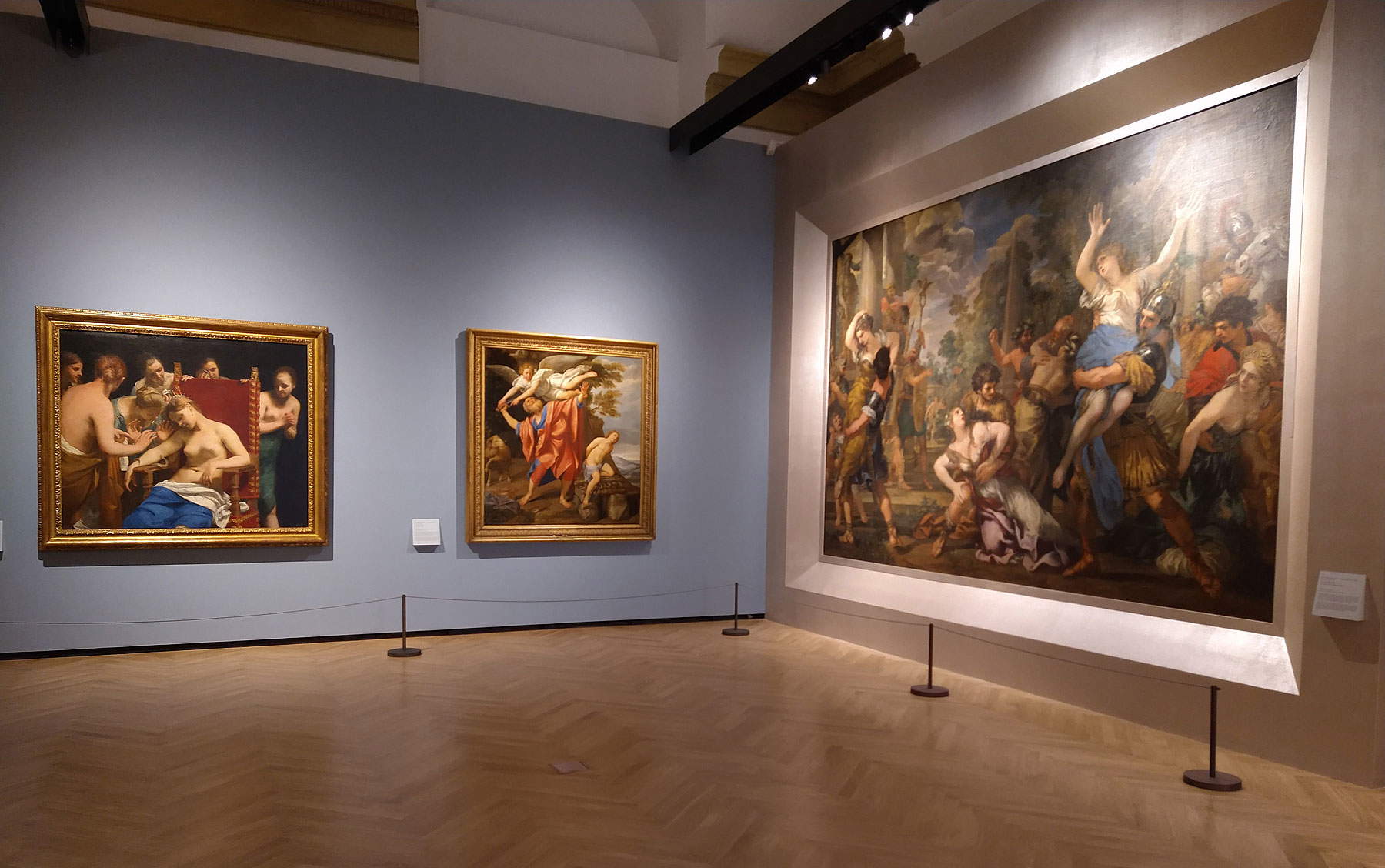 |
| Hall of the exhibition Tempo Barocco |
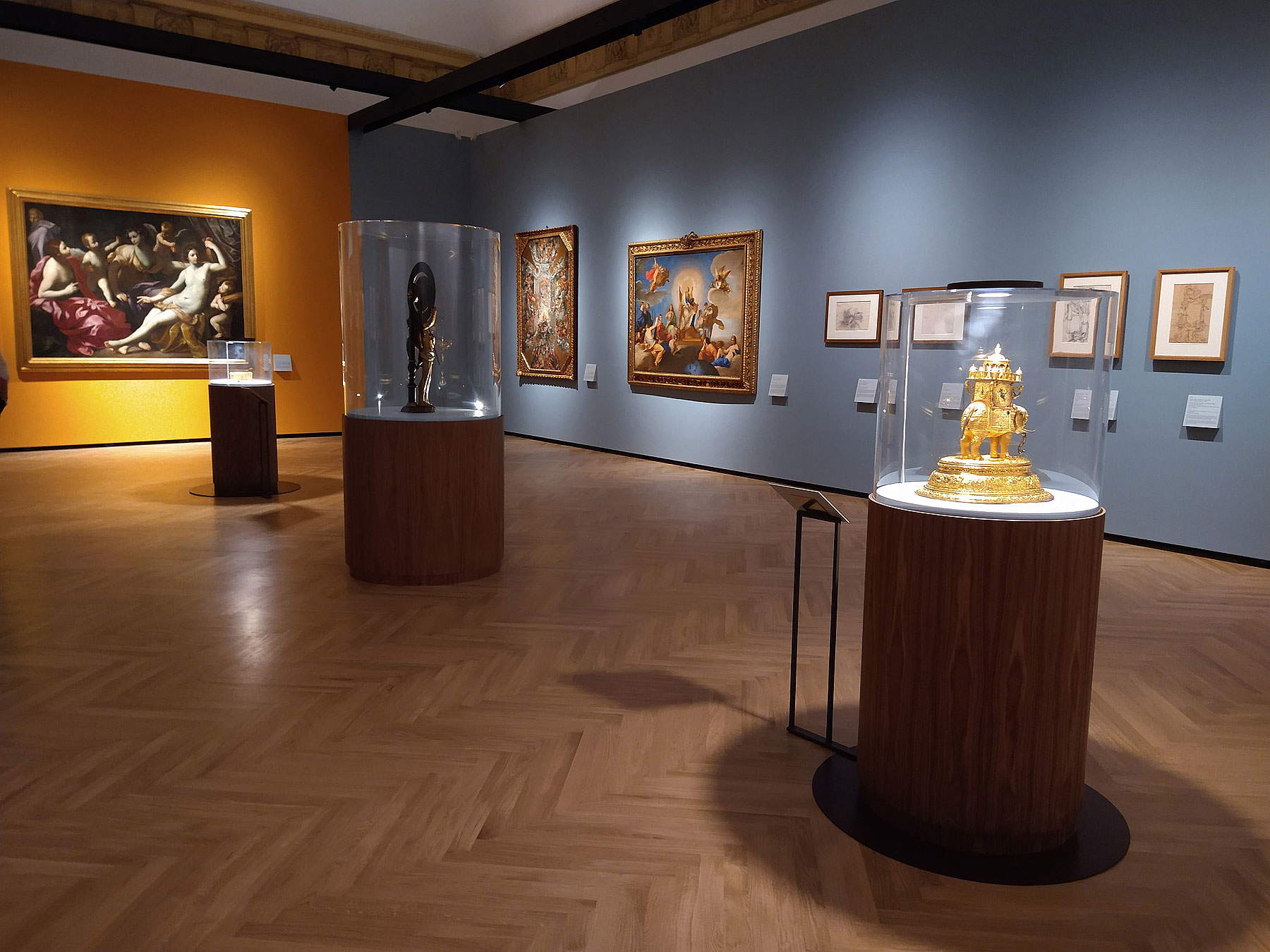 |
| Hall of the exhibition TempoBarocco |
 |
| Hall of the exhibition Tempo Barocco |
Introducing the exhibition are reproductions of two plates from Bilderatlas Mnemosyne, the invaluable collection of photographs of works of art resulting from the work of the German art historian Aby Warburg (Hamburg, 1866 - 1929): no. 48, Fortuna, and no. 70, Pathos Barocco del Ratto. In the same room, a timeline indicating the main historical and artistic events of the years between 1605 and 1665 can also be consulted, while in the next room a short video is projected that offers visitors an overview of Rome’s Baroque heritage, dwelling, with good reason, on the role of the Barberini and Borghese patrons. The first section of the itinerary displays a drawing now credited to Giovanni Battista Gaulli (Genoa, 1639 - Rome, 1709), from the 1740s and on loan from the Prado, which depicts what Gian Lorenzo Bernini ’s (Naples, 1598 - Rome, 1680) original design for his marble Truth , now housed in the Galleria Borghese, envisioned. Bernini conceived the work at a very complex time in his life, after the demolition of the bell tower of St. Peter’s that he had designed and the removal from the great Roman building sites by Innocent X, elected in 1644. In those years, then, the master designed his marble revenge: a reclining young woman, Truth, denuded by her father Time who reveals her to the world. The sculptural group was meant to express the truth of the artist’s innocence in the face of accusations, intolerable to him, that he had made serious mistakes in the design of the bell towers. However, the work was never completed, and only the female figure remained of the original idea. Time in Flight, as we see it in Gaulli’s drawing and, later in the exhibition, also in two Bernini sketches from Leipzig, was not sculpted. We find it, however, in the painting by the Umbrian Gian Domenico Cerrini (Perugia, 1609 - Rome, 1681) in the Kassel Gemäldegalerie, and it is portrayed by the painter as he does what he should also have done in Bernini’s sculpture, namely uncover Truth, who here, however, is clad in a snow-white robe, and not naked. The choice of placing the two works, the drawing and the painting, next to each other is, moreover, apt not only because of the recurrence, evident, of the same subject, but for the reason that both lead into the personal dimension, into the private time, of Bernini and Cerrini. Indeed, the latter was moved in the making of the painting by the same reasons that inspired Gian Lorenzo: he painted it after being heavily criticized for his pictorial decoration of the dome of Santa Maria della Vittoria in Rome, also hoping for his own full rehabilitation through the revelatory action of Time. Truth is thus “filia temporis,” as Aulus Gelio had written in the Noctes Atticae, and as popular wisdom continued to affirm in the years in which the two artists lived. But Time, even in this first room, is not only the elderly Chronos-Saturn of the Renaissance tradition, bearded and equipped with wings and scythe: it is also the presence, not perceptible by sight, that flows from face to face in the splendid canvas by Valentin de Boulogne (Coulommiers, 1591 - Rome, 1632), preserved at the National Gallery in London, The Four Ages of Man. In this masterpiece, the French painter depicts a child holding an empty cage, a young lute player, a soldier absorbed in reading, and an elegant old man counting coins scattered on the table in front of him, and places them in the tavern atmosphere so recurrent in Caravaggio’s painting of these years. This is a complex work with a strong intellectual component, created by the artist toward the end of the third decade of the seventeenth century.
Finally, the canvas by Antoon van Dyck (Antwerp, 1599 - London, 1641) from the Musée Jaquemart-André, Time Cuts the Wings to Love, dated 1627, introduces the protagonist from the next environment: Love. And in this context van Dyck’s work is all the more interesting because it runs counter to the iconographic tradition of the period, documented precisely in the second room, which almost always sees the young son of Venus imposing himself on everything, including Time.
So in the next section we encounter a sumptuous clock, restored just for this exhibition, from a private collection in Rome, and referable to the circle of the French chiseler and sculptor Andrés-Charles Boulle (Paris, 1642 - 1732). It is a gilded wooden artifact inlaid with bronze, tortoiseshell, ebony, and mother-of-pearl, showing, in the lower part, the old man lying down, winged and holding a scythe on the blade of which reads “Dum metiris méteris” (“As you measure you are mowed down”), while above the dial flies Love holding the palm of victory. Moreover, by Virgilian motto, “Omnia vincit Amor”: a concept, this, also reiterated by the two canvases by Tuscans Astolfo Petrazzi (Siena, 1583 - 1665) and Orazio Riminaldi (Pisa, 1593 - 1630). Replicating the figurative subject matter invented by Caravaggio’s celebrated painting Amor vincit omnia, from 1602, now in the Staatliche Museen in Berlin, both painters portray Love pointing to still lifes of objects symbolizing those activities through which men would like to overcome time, gain immortality, but over which he, eternal, prevails.
From the Galleria Borghese comes the jewel of this room: theAllegory of Sleep, a black marble sculpture by Alessandro Algardi (Bologna, 1598 - Rome, 1654), depicting a sleeping putto with butterfly wings. In his hair and in a bunch he holds in one hand we see poppies; on one side of the work appears a dormouse: these are some of the attributes of Sleep, included in observance of what Cesare Ripa indicated in his Iconologia. The presence of this marble depiction in the exhibition is interesting not only as a contaminated image of Cupid, but also as an allegorical element connected to the theme of the flow of time, in the alternation of day and night.
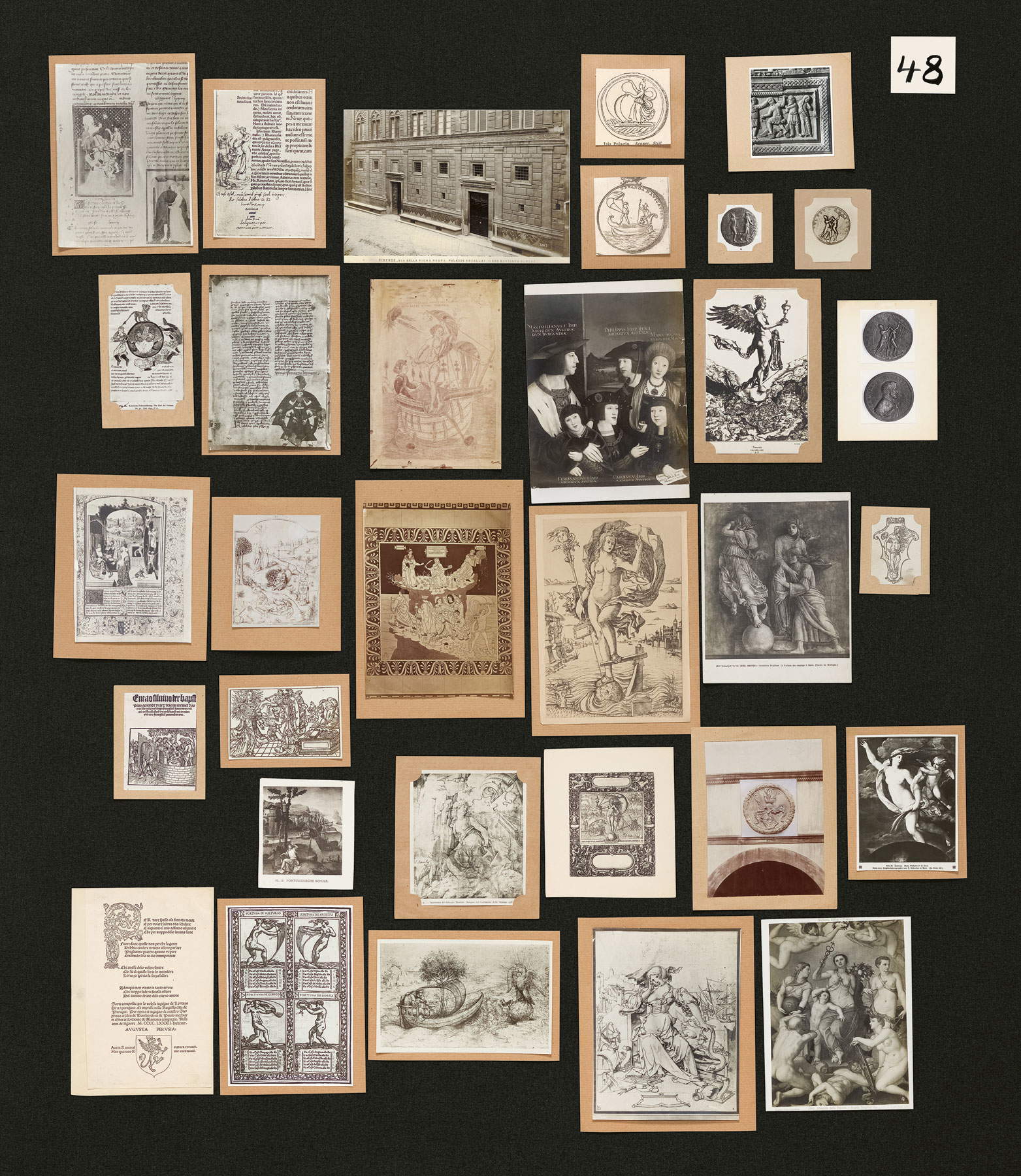 |
| Aby Warburg, Mnemosyne, panel 70: Baroque Pathos in the Rat (c. 1927; reproduction of the original; London, The Warburg Institute). Reconstruction by Axel Heil and Roberto Ohrt, 2020 Photo: Tobias Wootton © The Warburg Institute, London |
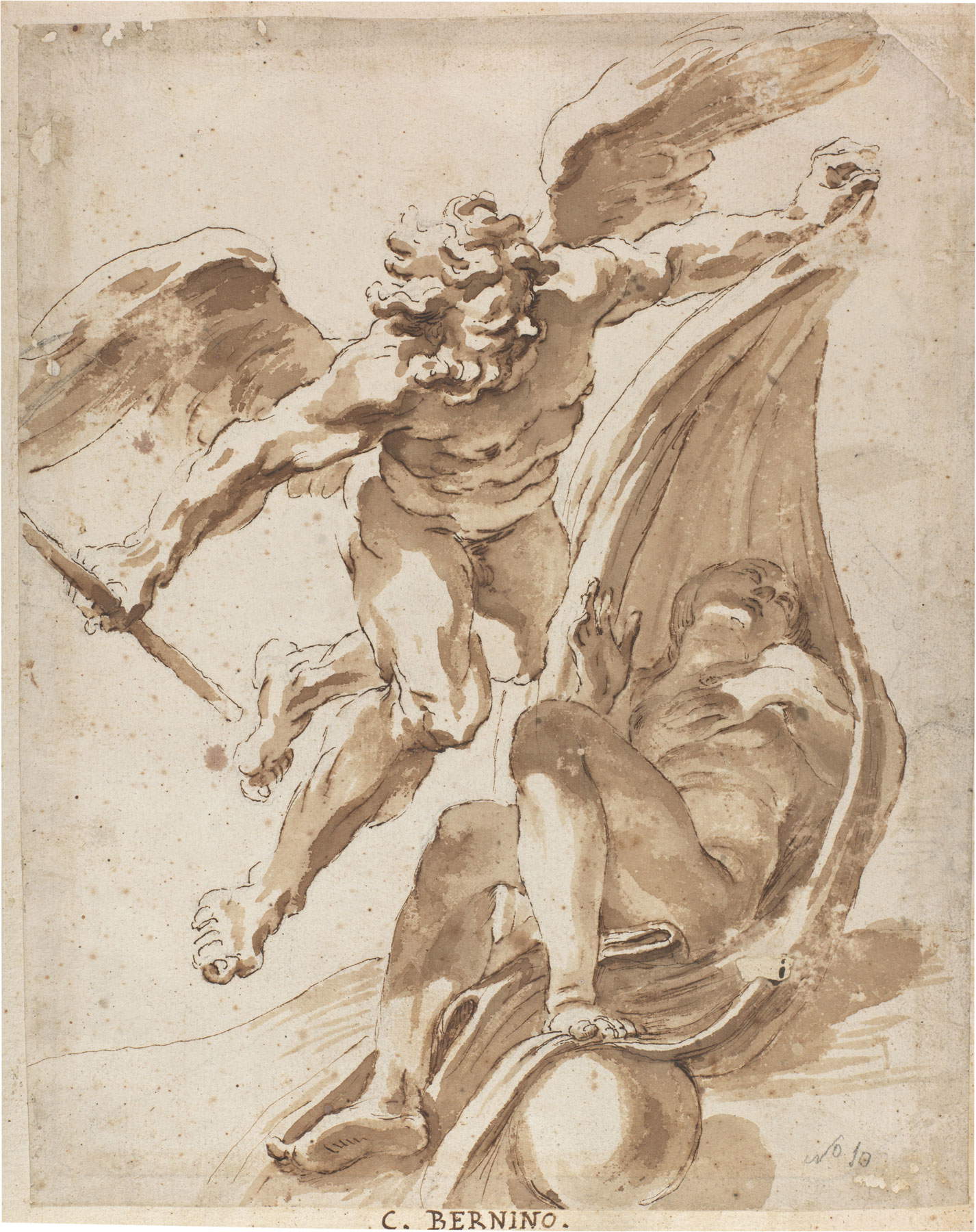 |
| Giovanni Battista Gaulli known as Baciccio, Allegory of Time and Truth (1646-1647; pen and brown watercolor on paper, 375 x 186 mm; Madrid, Museo Nacional del Prado) © Photographic Archive. Museo Nacional del Prado. Madrid |
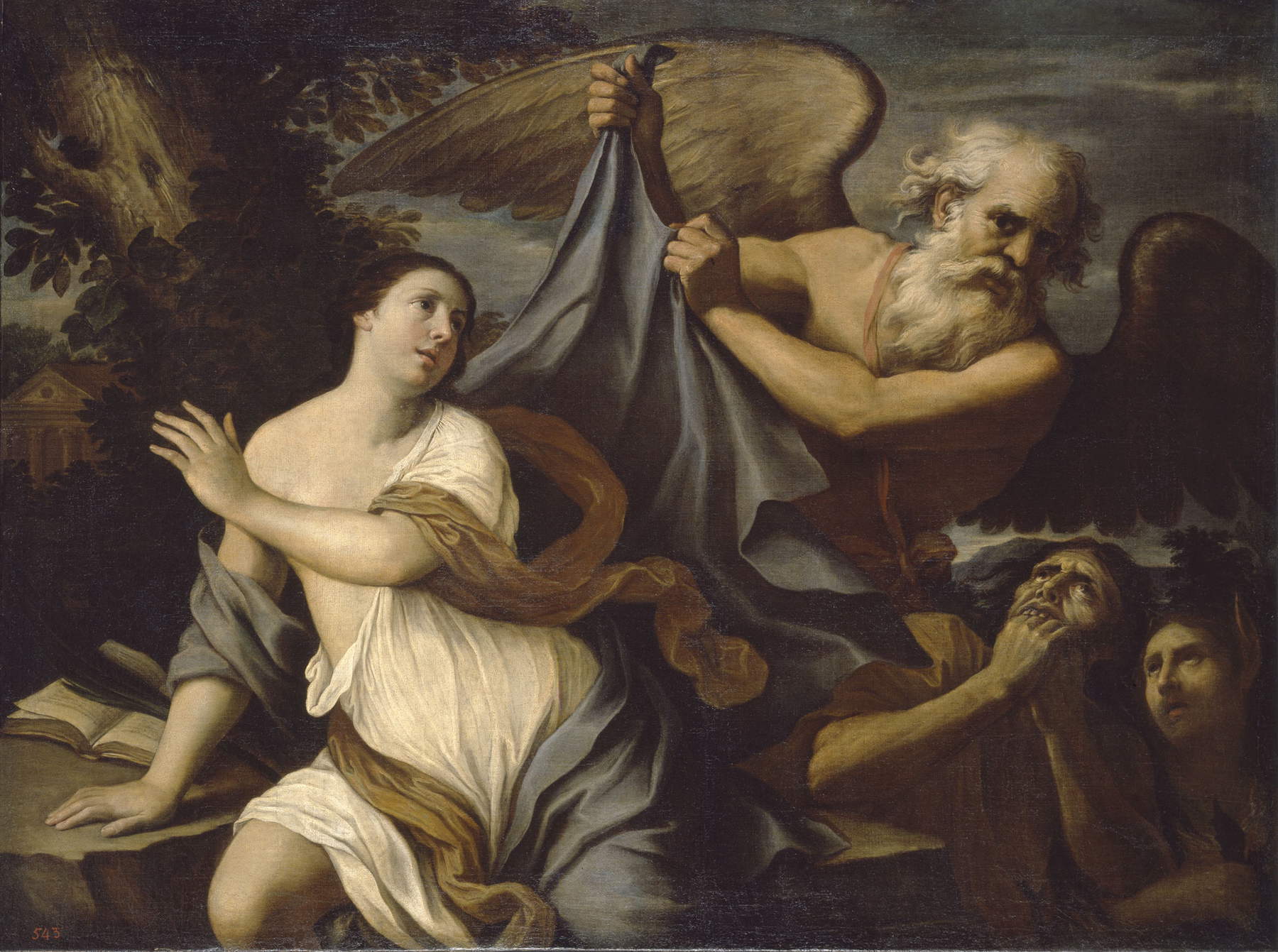 |
| Giovanni Domenico Cerrini, Time Reveals the Truth (c. 1666; oil on canvas, 127.5 x 171.5 cm; Kassel, Museumslandschaft Hessen Kassel, Gemäldegalerie Alte Meister) |
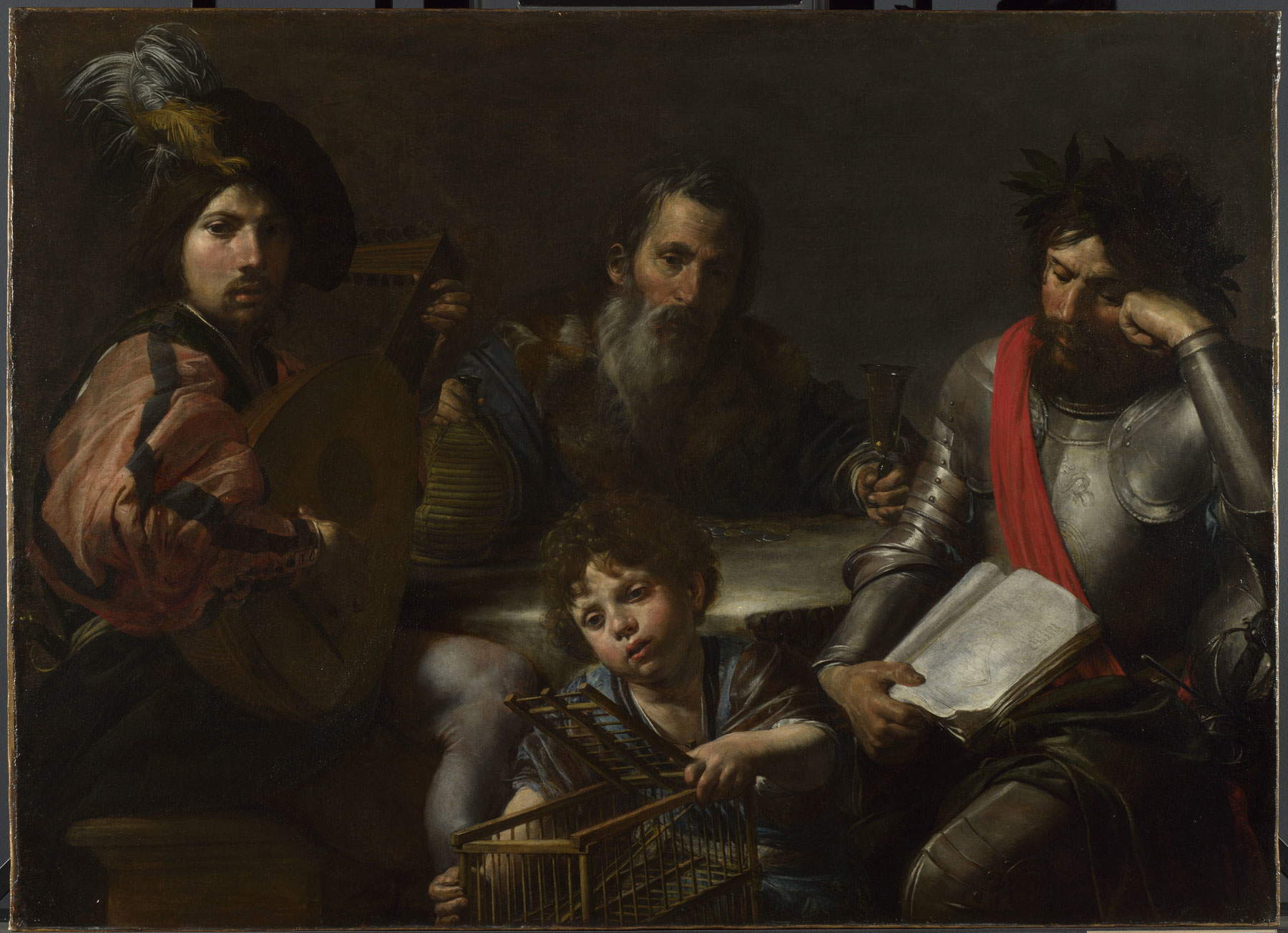 |
| Valentin de Boulogne, The Four Ages of Man (c. 1629; oil on canvas, 96.5 x 134 cm; London, The National Gallery) |
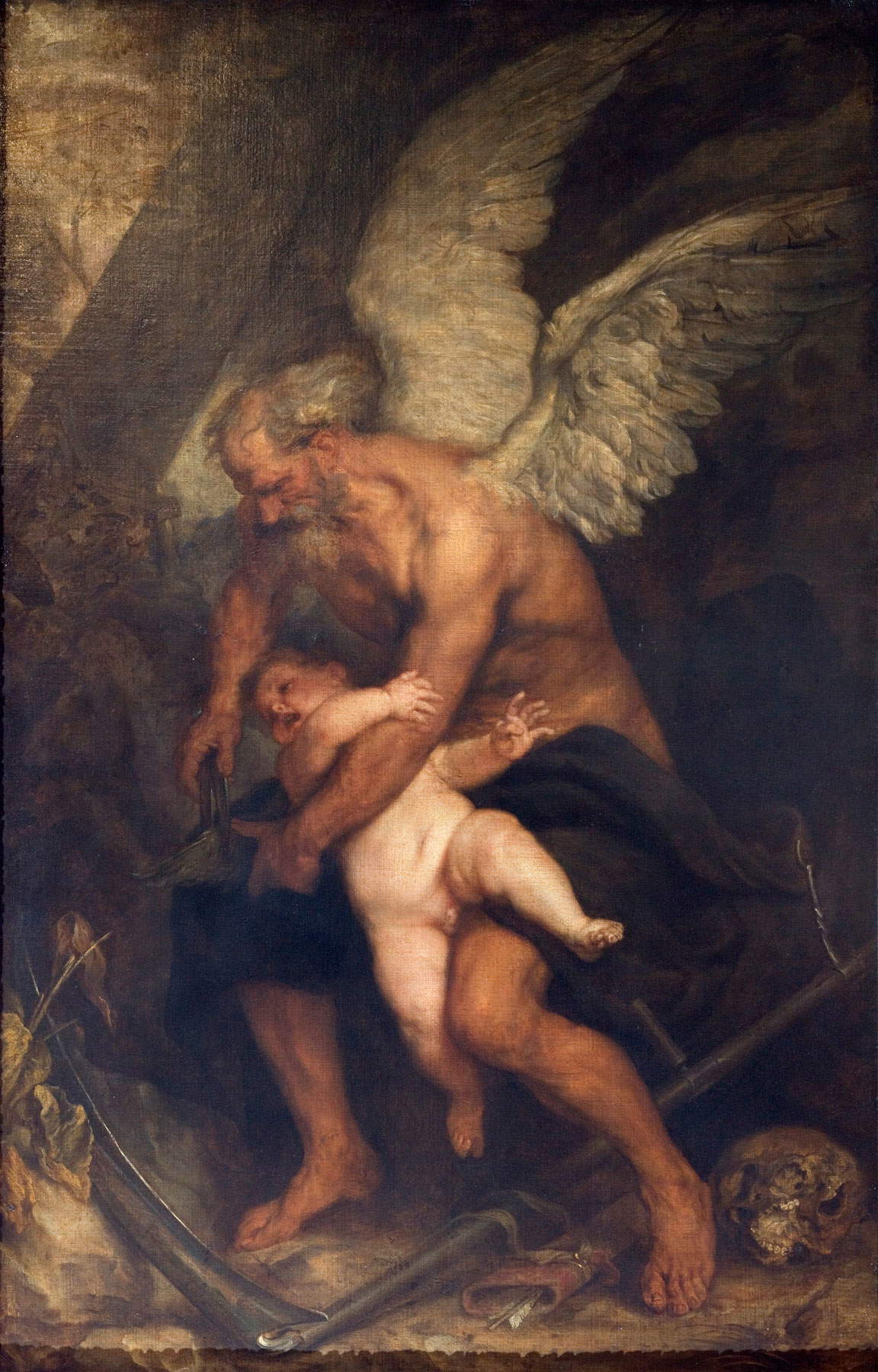 |
| Antoon Van Dyck, Time Cuts the Wings of Love (c. 1627; oil on canvas, 187 x 120.5 cm; Paris, Institut de France, Musée Jacquemart-André) © Christophe Recoura |
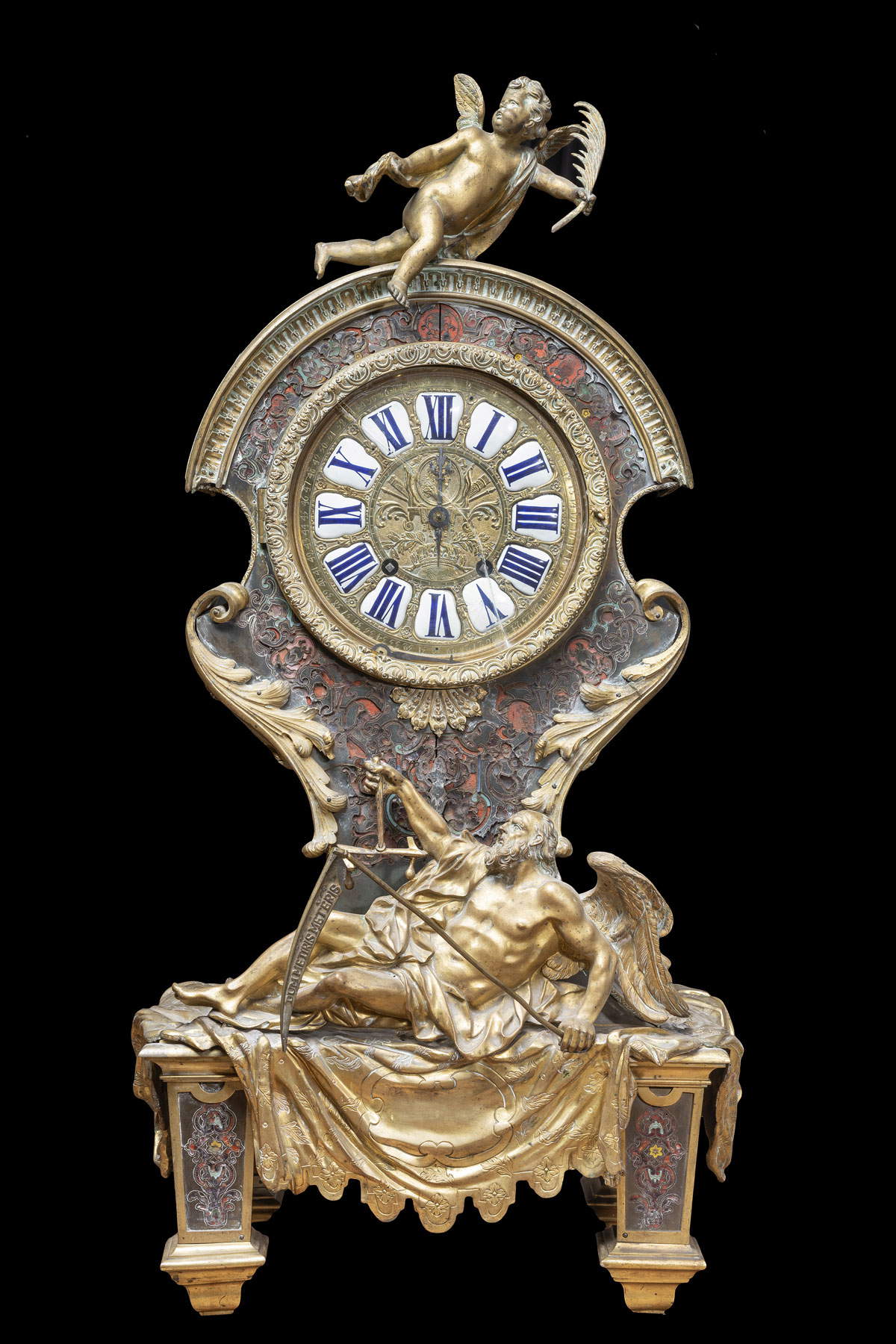 |
| Circle of André-Charles Boulle, based on a design by G. A. Pordenone, Console Clock with the Triumph of Love over Time (late 17th early 18th century; wood, tortoiseshell inlay, ebony, mother-of-pearl, bronze, and brass, 100 x 50 x33 cm; Rome, Private Collection). Photo Domenico Ventura |
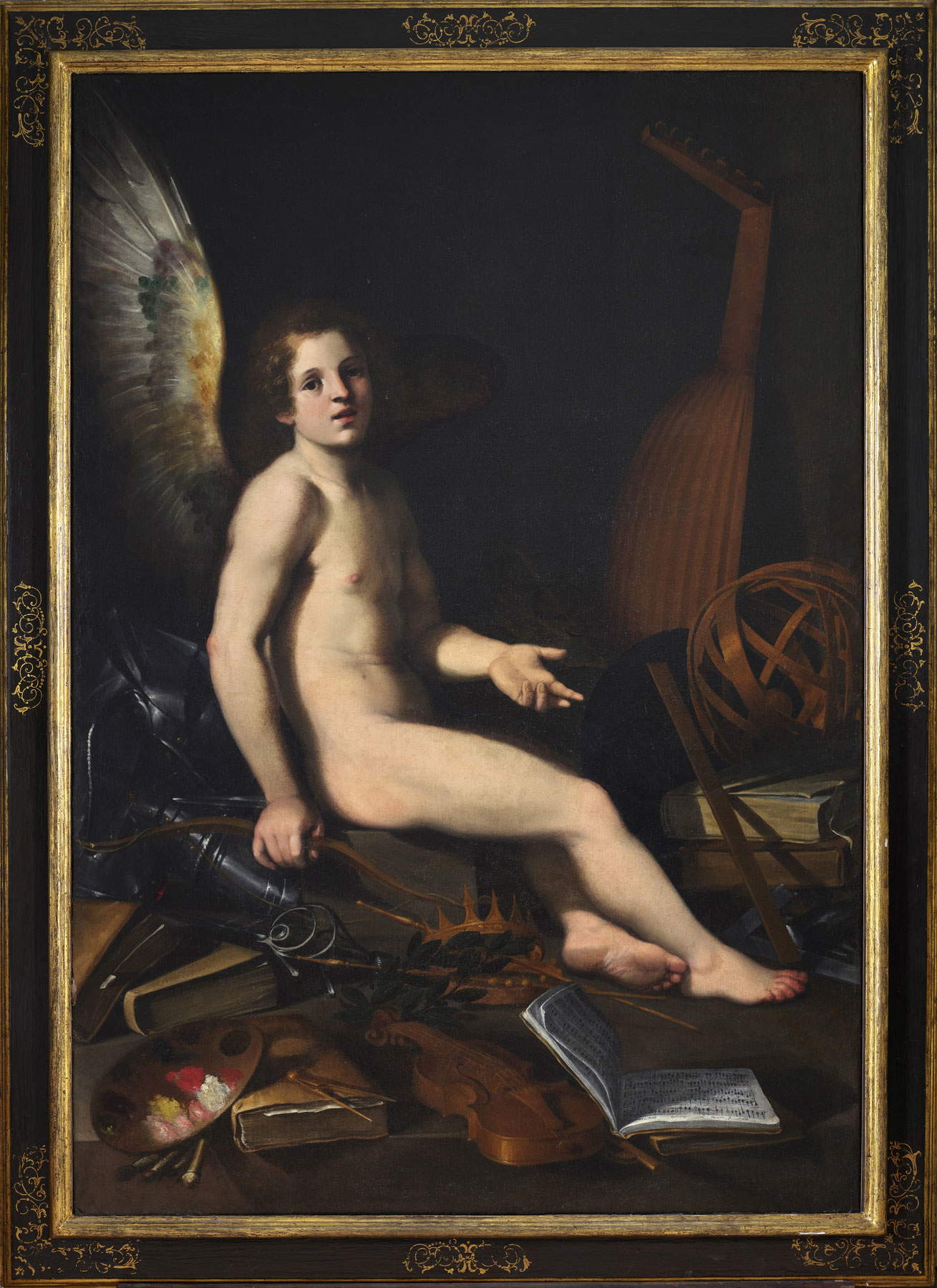 |
| Astolfo Petrazzi, The Genius of the Arts (Winning Love) (1628; oil on canvas, 169 x 117 cm; Rome, National Galleries of Ancient Art) © (MiC) - Bibliotheca Hertziana, Max Planck Institute for Art History/Enrico Fontolan |
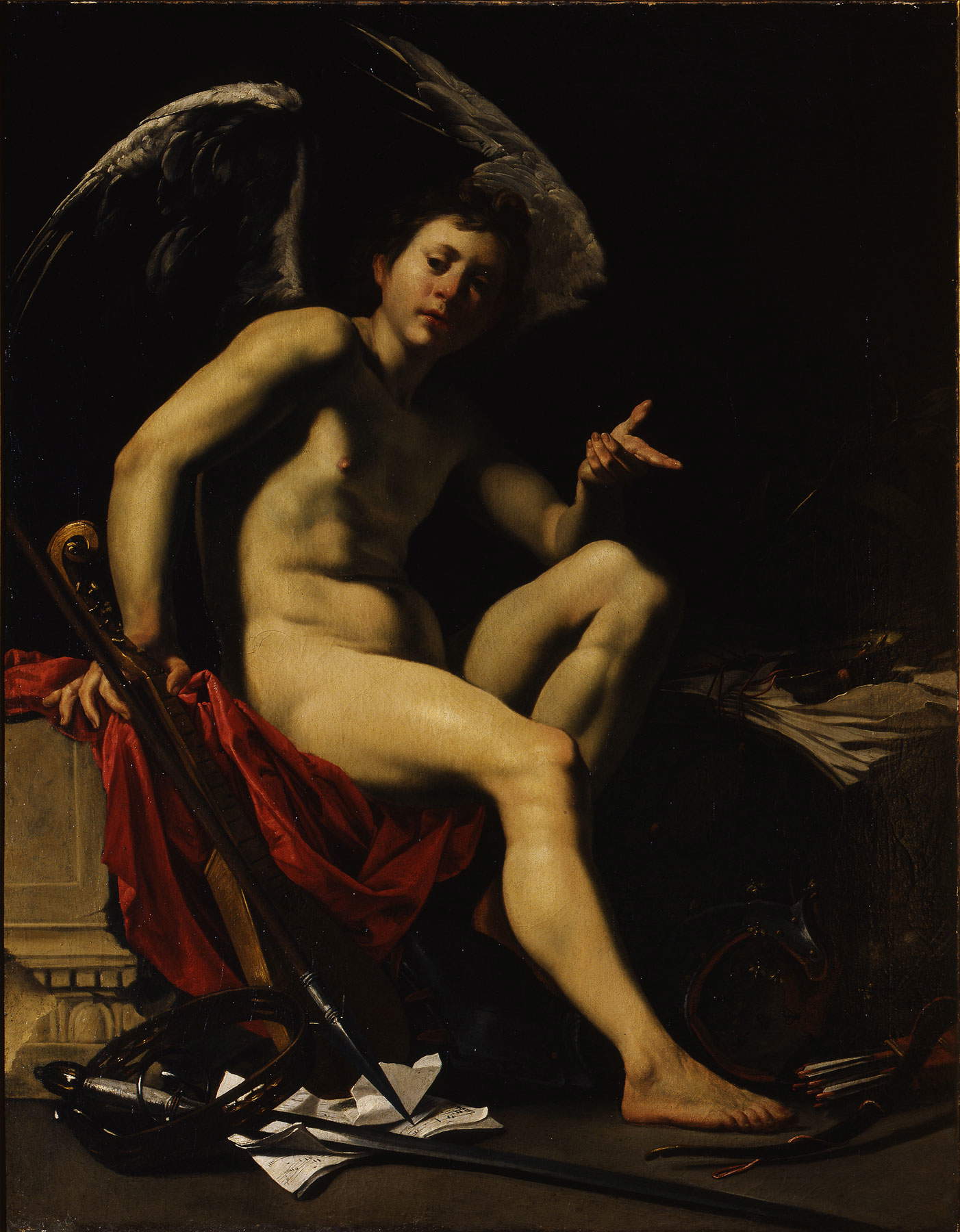 |
| Orazio Riminaldi, Amore vincitore (1624-1625; oil on canvas, 142 x 112 cm; Florence, Uffizi Galleries, Galleria Palatina) |
 |
| Alessandro Algardi, Allegory of Sleep (1635 1639; antique black marble, 48 x 90 cm; Rome, Galleria Borghese) |
Continuing along the path we come to the third and richest section of the exhibition, in which are housed graphic and pictorial works featuring the female allegories that recur often, in the seventeenth century, associated with Time. A preparatory drawing and two canvases, offer valuable evidence, here on display, of the frescoes that decorate Palazzo Barberini, and with which Andrea Sacchi (Rome, 1599 - 1661) and Pietro da Cortona (Pietro Berrettini; Cortona, 1596 - Rome, 1669) celebrated Maffeo Barberini, elected pontiff with the name Urban VIII in 1623, and his family.
The drawing, from the Kunstpalast in Düsseldorf, is by Sacchi and depicts Divine Wisdom, the central figure in what was to be his pictorial endeavor, theAllegory of Divine Wisdom, a fresco executed on the vault of one of the building’s rooms. It is reproduced in a canvas by the same artist, exhibited here and belonging to the collection of the National Galleries of Ancient Art in Rome, which Cardinal Antonio Barberini acquired in 1658 to make a gift to Pope Alexander VII. There is no shortage of differences with the fresco, but the most obvious one can be seen on the throne of Wisdom, on whose base the Chigi coat of arms appears in the painting. The painting of the vault had been completed by Sacchi in 1631 and expressed a fundamental concept: in the leadership of the Church, Urban was flanked by Heavenly Wisdom, depicted among many other allegorical figures, including Eternity.
From 1632 to 1639 Pietro da Cortona worked on the decoration of a larger and more prestigious ceiling, that of the palace’s salon, and in much higher tones he joined Sacchi in exalting the Barberini pontificate with his Triumph of Divine Providence. In the exhibition we see its transposition on canvas, also owned by Rome’s National Galleries, made within the master’s circle of assistants. It is clear that this is a fundamental presence in the context of an itinerary focused on Baroque culture, moreover, an itinerary set up right inside the palace where the fresco still makes a splendid display, because with it, as Paola Nicita writes in the catalog entry for the canvas, “Pietro da Cortona crossed the sophisticated boundary between reality and wonder and invented the new visual language of political absolutism, the Baroque, while renewing the cultural primacy of the Rome of Raphael and Michelangelo.” In the painting, and of course in the huge original work, a multitude of allegorical figures, often little known or even newly invented, and mythological and historical figures overwhelmingly invade the architecture and the sky, with which the spatial limit of the real ceiling is exceeded. Among them (as already mentioned) Kronos devours his children, just below Providence’s throne of clouds, next to him the Fates weave, while on the opposite side, at Providence’s command, Eternity crowns the coat of arms of the ruling family, the three bees that the great art historian Giulio Briganti, in words that have remained understandably famous, described in his monograph on Berrettini as “roaring like planes in formation.” The glory of the Barberini is thus removed from the destructive action of Time, by divine will.
To the pageantry of palace life also refer the two drawings that depict, one more the other less faithfully, the mirror made by Ercole Ferrata to Bernini’s design for Queen Christina of Sweden, who, after abdicating and residing in several European cities, settled in Rome in 1655. The precious artifact has been lost, but we know that the former sovereign kept it with her at the present Palazzo Corsini (another site of the National Galleries of Ancient Art) where she lived for three decades until her death. Both drawings come from the Nationalmuseum in Stockholm, and both are of uncertain attribution, but while one likely depicts the mirror as it could be admired in the Roman palace, the other, in which we see two mighty tritons serving as the base, is now generally considered by scholars to be an imaginative reinterpretation of the work conceived by Bernini by one of his followers. The sheet presenting the faithful copy of the mirror shows us a simpler, though no less fascinating, elaboration of the subject of Truth Unveiled by Time. The intuition behind it is simple and effective, and far from flattering: the winged old man is caught in the act of lifting, from the top of the mirror, a drape, thus leaving the surface free to reflect the image of the queen, on whose face it was thus legible, from day to day, the truth of the passage of years and the looming of the end. Autographs of Bernini, on the other hand, are the two drawings also exhibited in this room, depicting his design for the Truth now in the Borghese Gallery, which have already been mentioned.
We cannot, moreover, fail to mention three other splendid works we encounter here: the canvas with The Four Seasons by Guido Reni (Bologna, 1575 - 1642), from the Capodimonte Museum, Time Defeated by Hope and Beauty painted by Simon Vouet (Paris, 1590 - 1649), from the Prado, and the Allegory of Time (or Life) by Guido Cagnacci (Santarcangelo di Romagna, 1601 - Vienna, 1663). In the latter painting, owned by the antiquarian Lampronti Gallery in London, the great Romagna painter (of whom, moreover, at Palazzo Barberini is exhibited, in the permanent collection, a superb Penitent Magdalene) depicts a young woman, naked to the lap, holding in one hand a rose and a dandelion, symbols, along with the attractive female body, of the transience of worldly pleasures, and with the other an hourglass, a perennial reminder of the passing of time, placed not coincidentally above a skull. The woman turns her gaze upward to an ouroboros, the serpent eating its own tail, an image of that eternity to which, the canvas suggests, one can aspire only by freeing oneself from the ballast of earthly things. On the same subject, always giving space to that marked sensuality that distinguishes his production, Cagnacci returned several times throughout his career.
“Vanitas vanitatum et omnia vanitas” (“Vanity of vanities and all is vanity”) is theincipit ofEcclesiastes, and from this comes the term used to refer to a theme much dealt with by 17th-century pictorial art, that, precisely, of Vanitas,to which the penultimate section of the exhibition is dedicated. What paintings of this genre express is a bitter reflection on the fragility of the human condition, on the tragic fate of man who is invariably condemned to cease to exist, a reflection that is manifested in the depiction of still lifes of various objects, alongside which appear skulls, candles, clocks, hourglasses, insects, or rotten fruit, or withered flowers, to remind us of the inevitable transience of everything.
Three of the four paintings on display in this room were executed in the early 18th century by German painter Christian Berentz (Hamburg, 1658 - Rome, 1722), and come from the Corsini branch of the Gallerie Nazionali d’Arte Antica in Rome. Berentz’s refined still lif es enjoyed considerable success in papal cities, thanks to his skillful imitative precision of life and great compositional sensitivity, also evident in the works on display. All three canvases depict set tables; in one of them alongside precious crystal and ceramics is abandoned, eloquent, a clock.
And speaking of eloquence, in the center of the room a clock that is real, and older than Berentz’s paintings by more than half a century, is visible, among others, in all its peculiar charm. It is a seventeenth-century artifact made of crystal, gold, enamel, pearls and precious stones, designed by Christian Giessenbeck (active in Augsburg 1640 - 1660), also a German, and housed in Zurich by the Schweizerisches Nationalmuseum. On a rotating dial sits a laurel-crowned skeleton, Death Triumphant, indicating the hour with a long arrow. Below it is possible to see the gears of the mechanism through the crystal of the cylinder in which they are inserted. Particularly rich is the lower part of this little treasure, in which a circular band decorated with enameled flowers, pearls and stones surmounts little feet of skulls and bones.
 |
| Andrea Sacchi, Allegory of Divine Wisdom (1655-1658; oil on canvas, 160 x 208 cm; Rome, National Galleries of Ancient Art) © (MiC) - Bibliotheca Hertziana, Max Planck Institute for Art History/Enrico Fontolan |
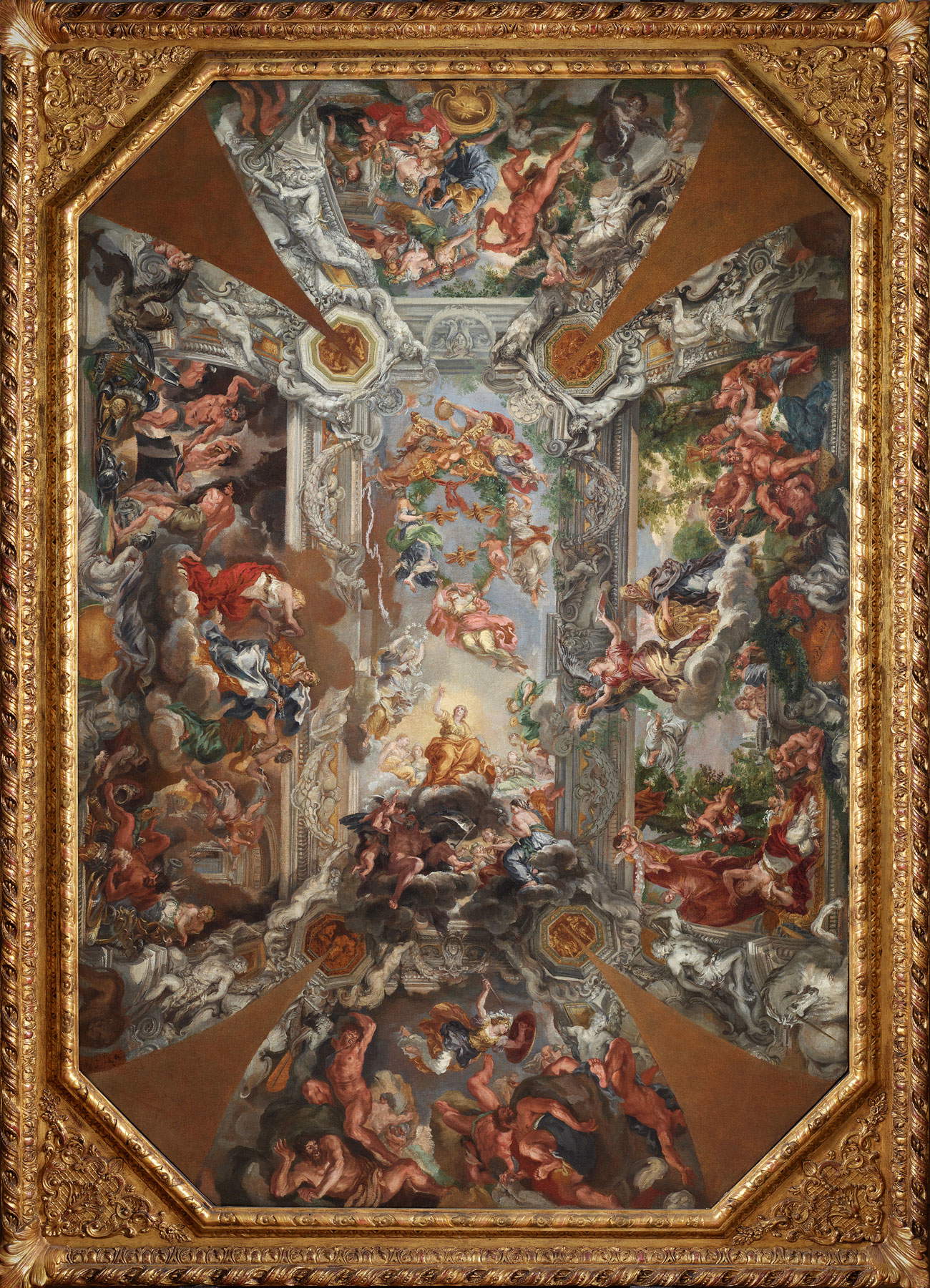 |
| School of Pietro da Cortona, Triumph of Divine Providence (post 1639; oil on canvas, 168 x 113 cm; Rome, Gallerie Nazionali di Arte Antica) ©(MiC) - Bibliotheca Hertziana, Max Planck Institute for Art History/Enrico Fontolan |
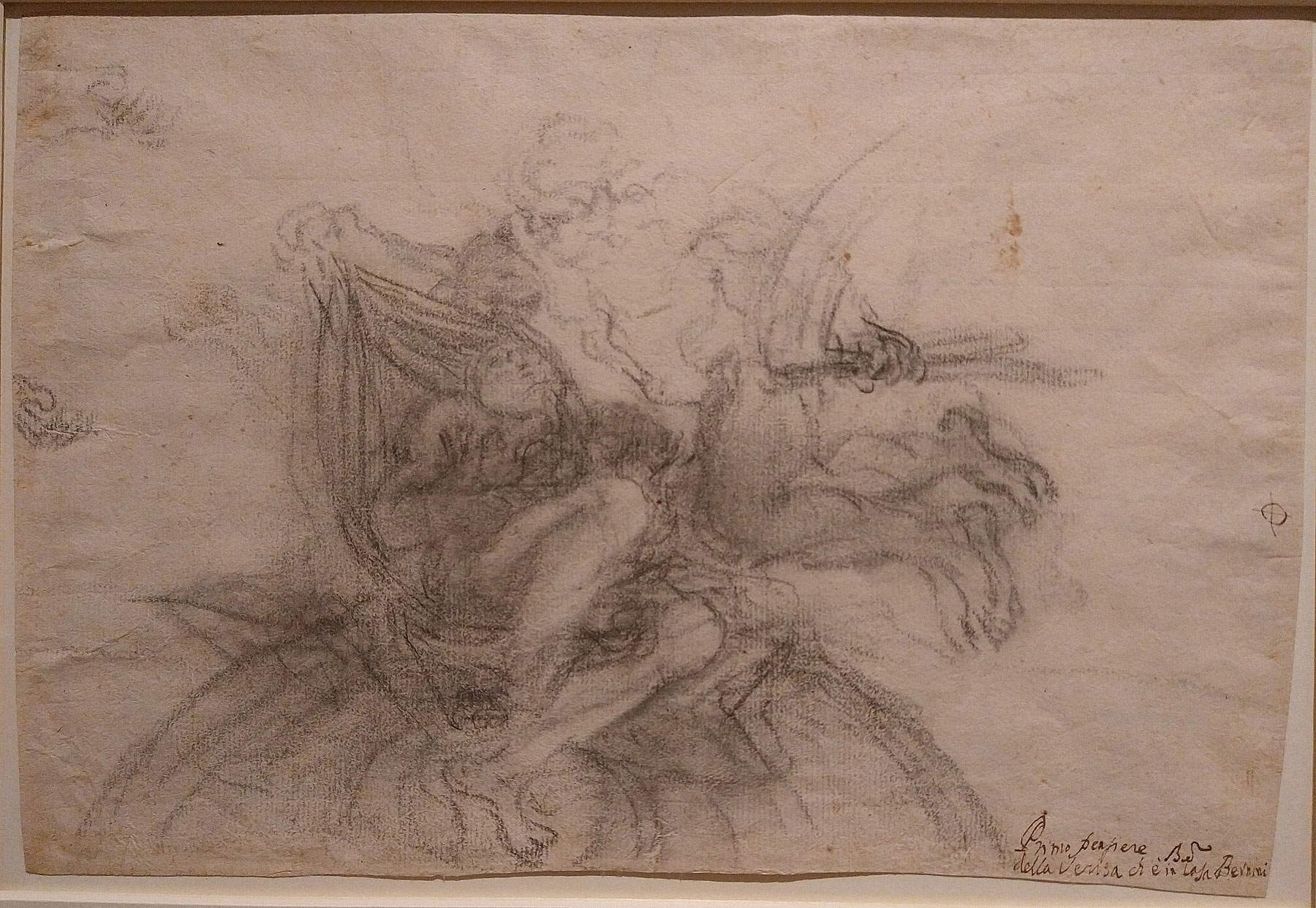 |
| Gian Lorenzo Bernini, La Verità svelata dal Tempo (1646; chalk on paper, 252 x 369 mm; Leipzig, Museum der Bildenden Künste) |
 |
| Artist active in Rome around 1685, Drawing for a Mirror with Winged Time Supported by Two Tritons (c. 1668; pen and brown watercolor on watermarked paper, 392 x 260 mm; Stockholm, Nationalmuseum) © Photo: Linn Ahlgren/Nationalmuseum |
 |
| Nicodemus Tessin the Younger, Copy of Bernini’s Mirror for Queen Christina of Sweden (c. 1680; graphite traces, pen and gray watercolor ink on paper, 404 x 272 mm; Stockholm, Nationalmuseum © Photo: Hans Thorwid/Nationalmuseum |
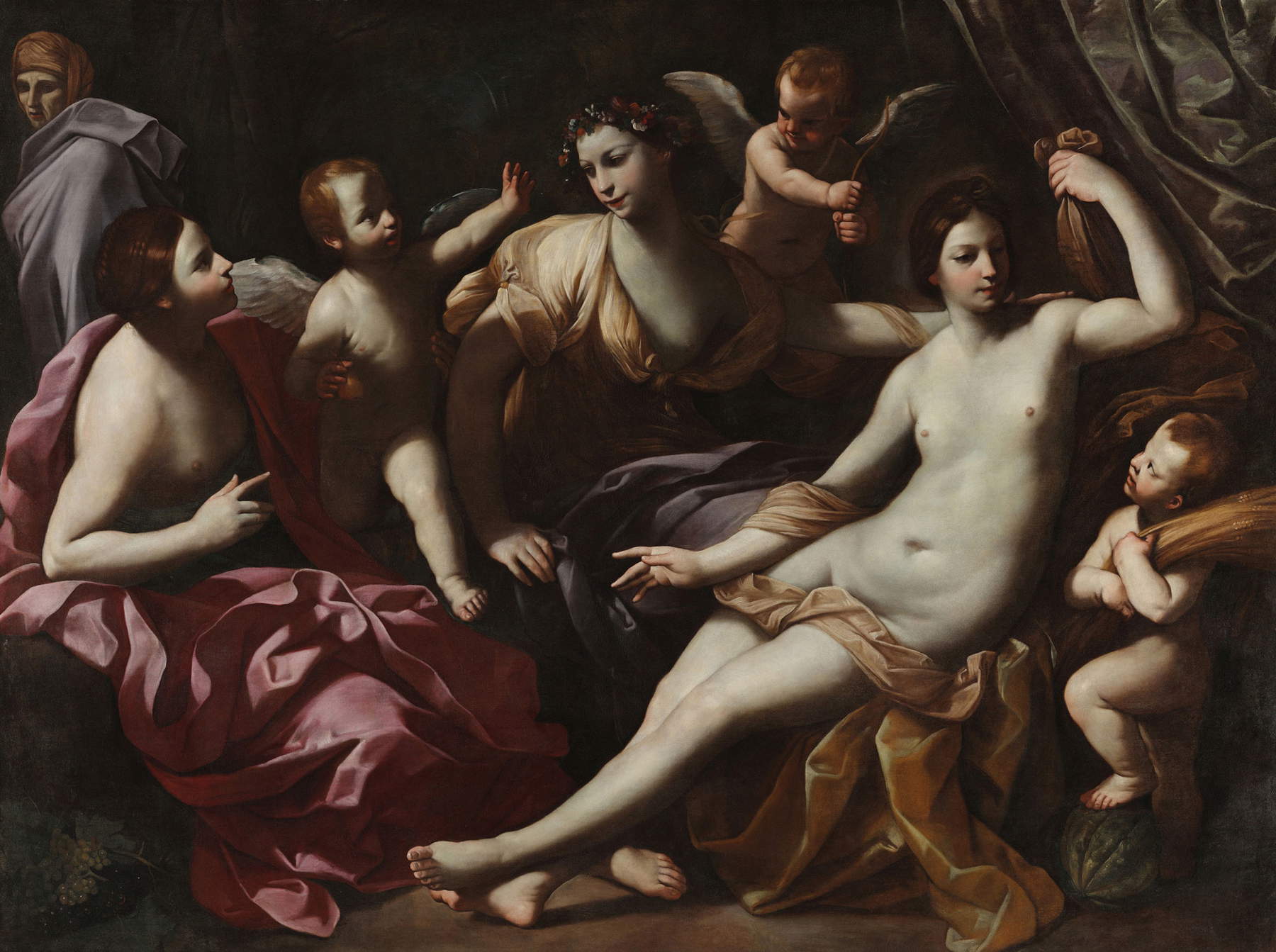 |
| Guido Reni, The Four Seasons (1617-1620; oil on canvas, 175 x 230 cm; Naples, Museo e Real Bosco di Capodimonte) |
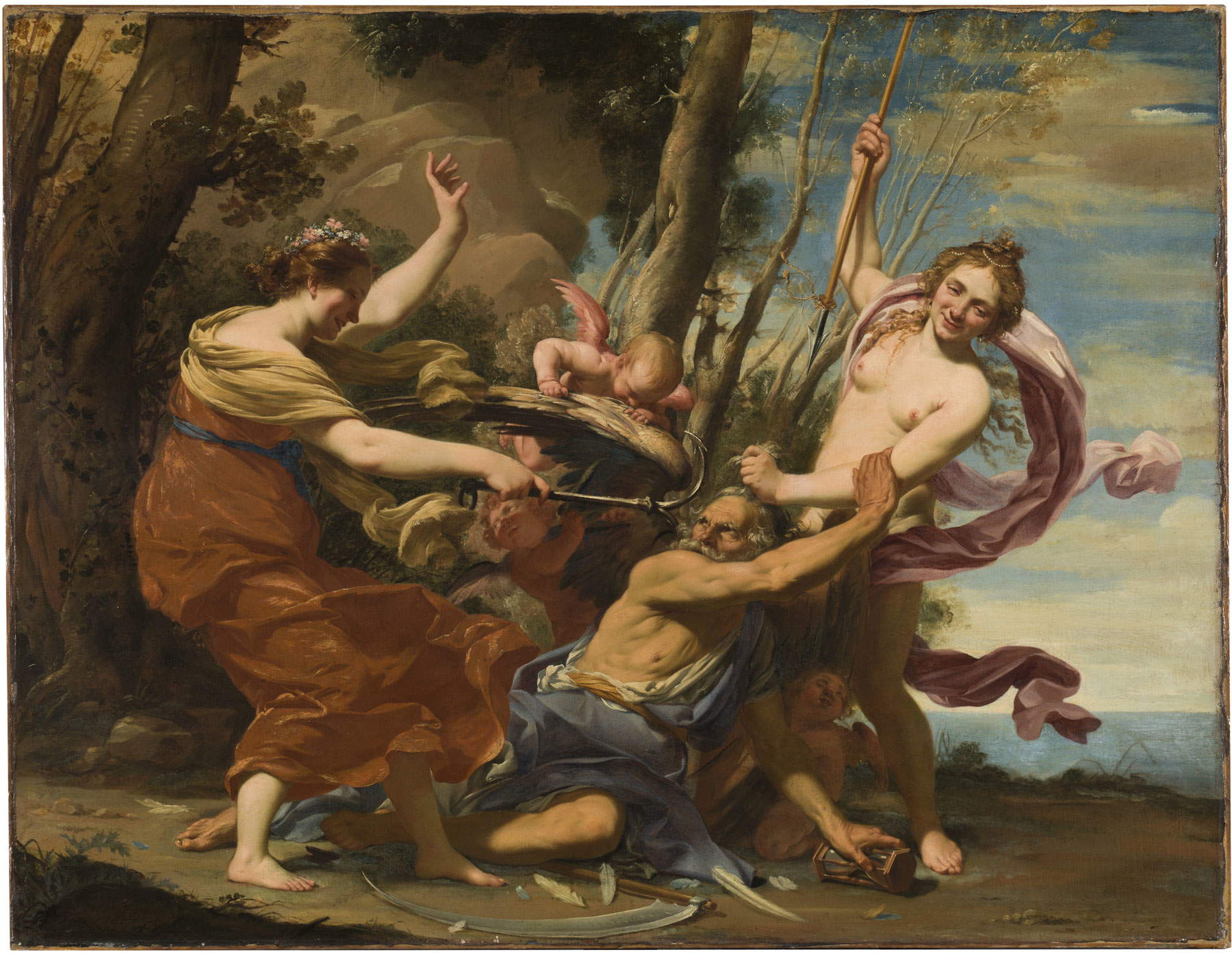 |
| Simon Vouet, Time Defeated by Hope and Beauty (1627; oil on canvas, 107 x 142 cm; Madrid, Museo Nacional del Prado) © Photographic Archive. Museo Nacional del Prado. Madrid |
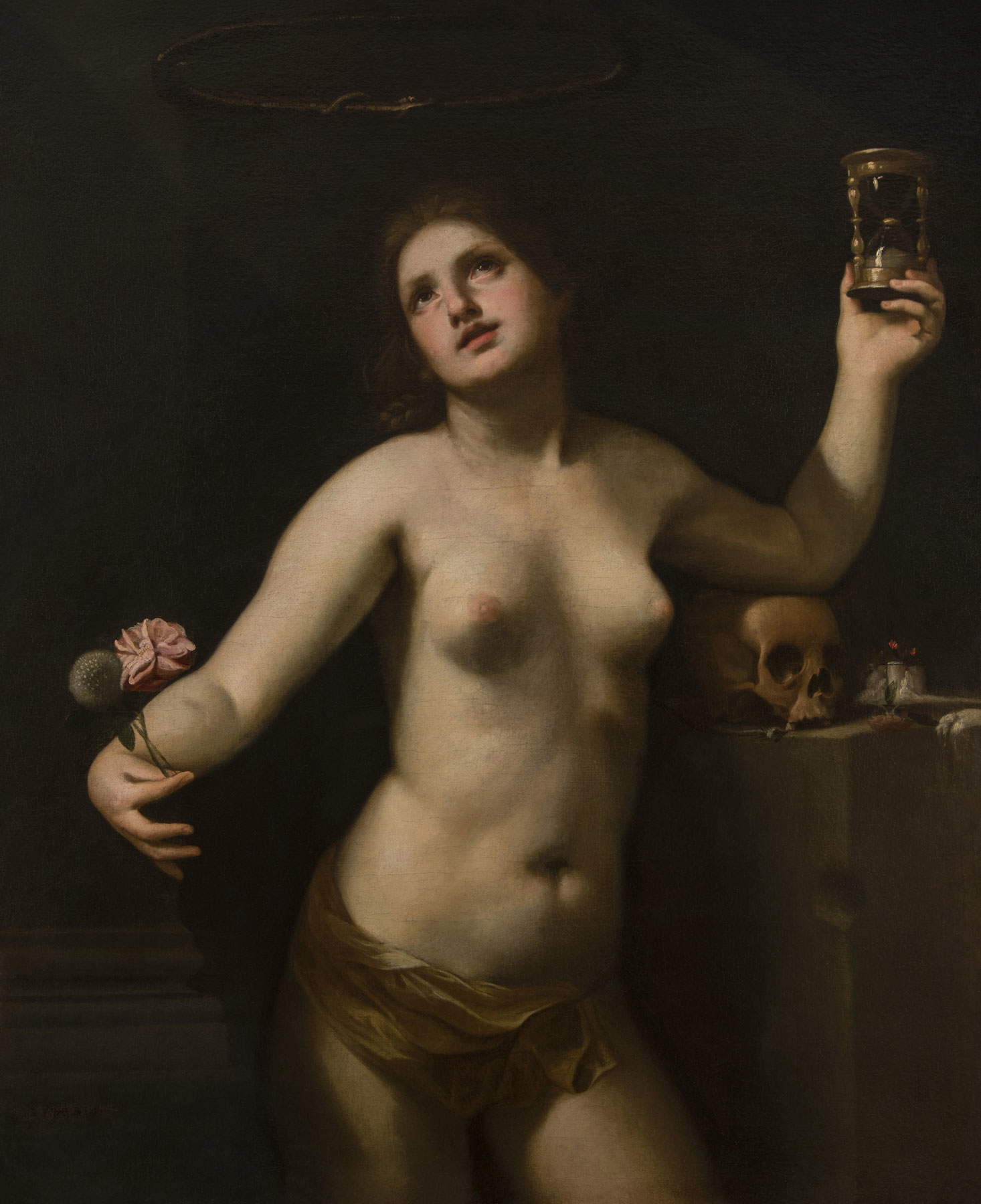 |
| Guido Cagnacci, Allegory of Time (or Human Life) (c. 1650; oil on canvas, 118.2 x 95.3 cm; Lampronti Gallery) |
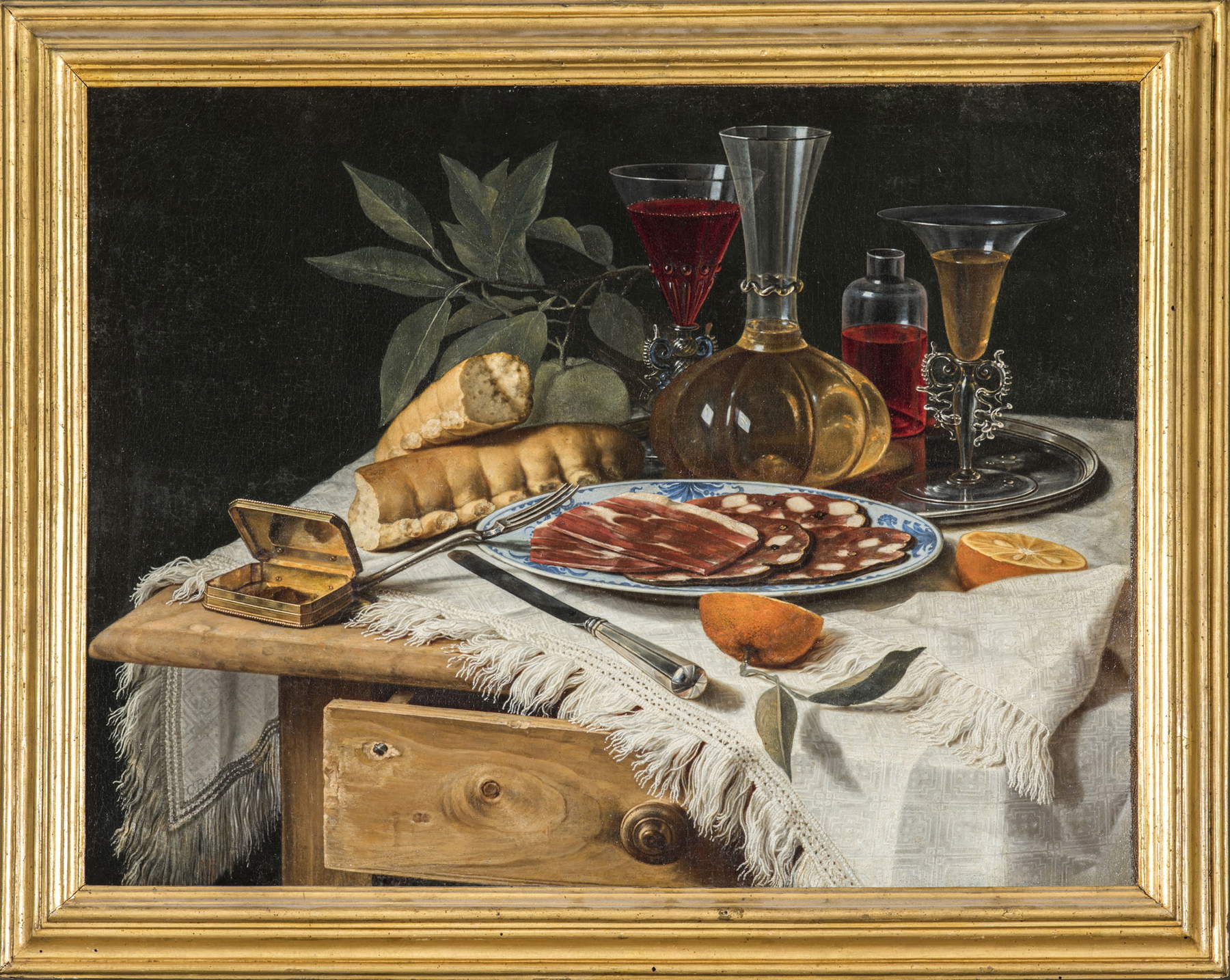 |
| Christian Berentz, The Elegant Snack (initialed and dated 1717; oil on canvas, 52 x 67.5 cm; Rome, Gallerie Nazionali di Arte Antica) ©(MiC) - Bibliotheca Hertziana, Max Planck Institute for Art History/Enrico Fontolan |
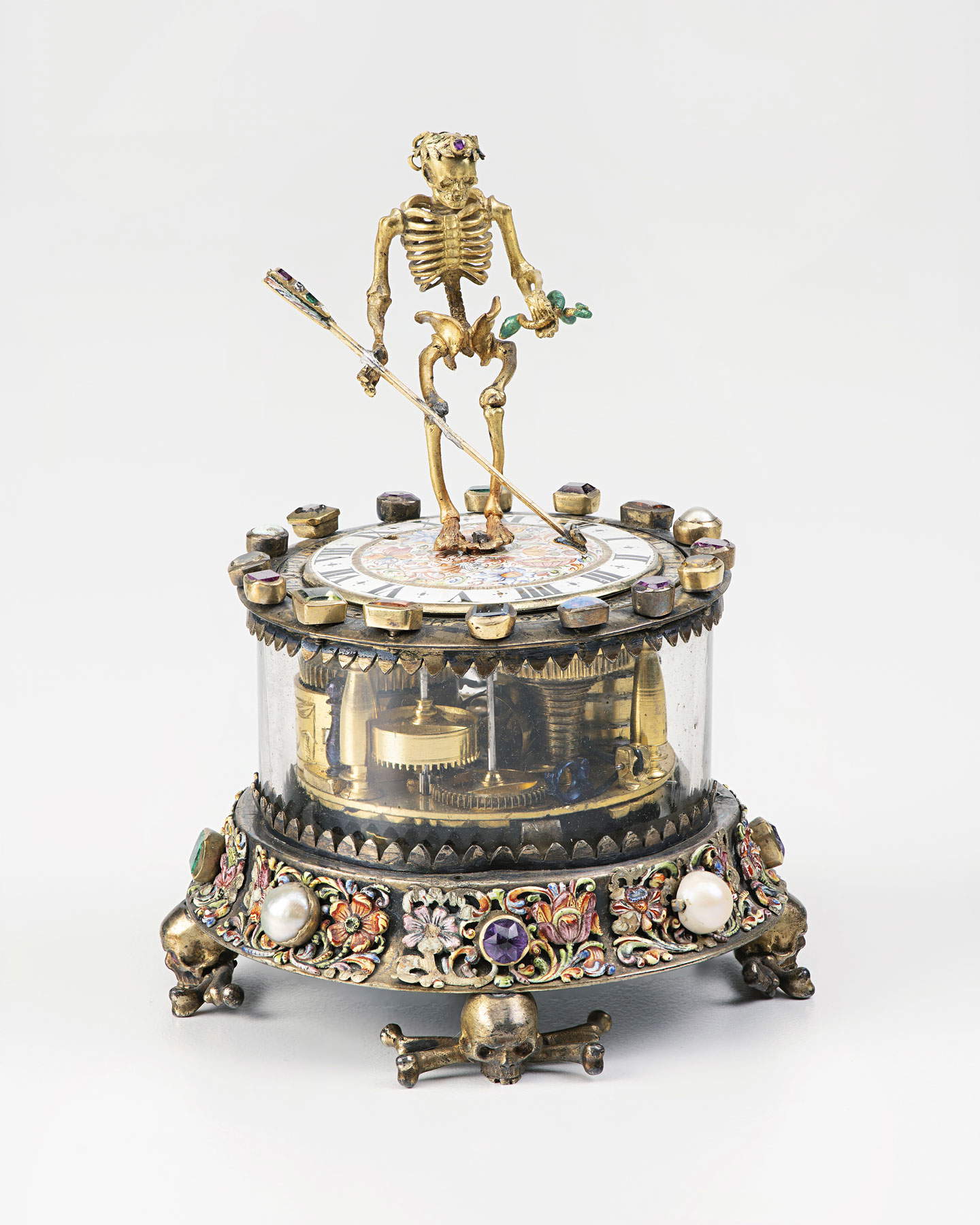 |
| Christian Giessenbeck, Skeleton Clock (16401660; gold, enamels and precious stones, height 10 cm; Zurich, Swiss National Museum) |
We come, then, to the last room of the exhibition, which closes the tour with a timely reflection on the relationship between time and the artist, and the need for the latter to govern the former. If, in fact, theatricality, and the ability to arouse awe, to emotionally engage the viewer are among the best known and immediately perceptible characteristics of Baroque art, they presuppose the ability ideational and executive ability to stop the time of the story at its expressive apex, through effective rendering of movement, whether one chooses to depict a single significant instant of what is being narrated, or to portray several moments side by side.
Of key importance in this room is the presence of Pietro da Cortona’s painting The Rape of the Sabine Women, on loan from the Capitoline Museums, which Briganti still called “the first spectacular statement of Roman Baroque methods in painting.” Executed a decade before the completion of the cyclopean Barberini fresco, the large canvas shows an overcrowded scene of figures arranged on multiple planes in depth, pervaded by a dramatic centrifugal motion. The episode is revisited by Berrettini by juxtaposing the moment of the actual rape, which takes place in the foreground, with the earlier one in which Romulus, cloaked in red between the columns on the left, gives orders to his men to abduct the Sabine women. In the even larger painting by Andrea Camassei (Bevagna, 1602 - Rome, 1649), depicting the Slaughter of the Niobids, from the collection of Palazzo Barberini, the tragedy of the killing of the fourteen children of Queen Niobe, so punished by Diana and Apollo for her pride, is consummated before us in its entirety, all in one scene.
Again, in The Death of Cleopatra, painted by Cagnacci in the 1760s and from the Kunsthistoriches Museum in Vienna, we witness the staging of all the feelings aroused by Cleopatra’s death in her handmaids, in which the painter declines the figure of one and the same model: dismay, disbelief, despair, and resignation alternate in the facial expressions and gestures of the women arranged around the queen’s magnificent half-naked body.
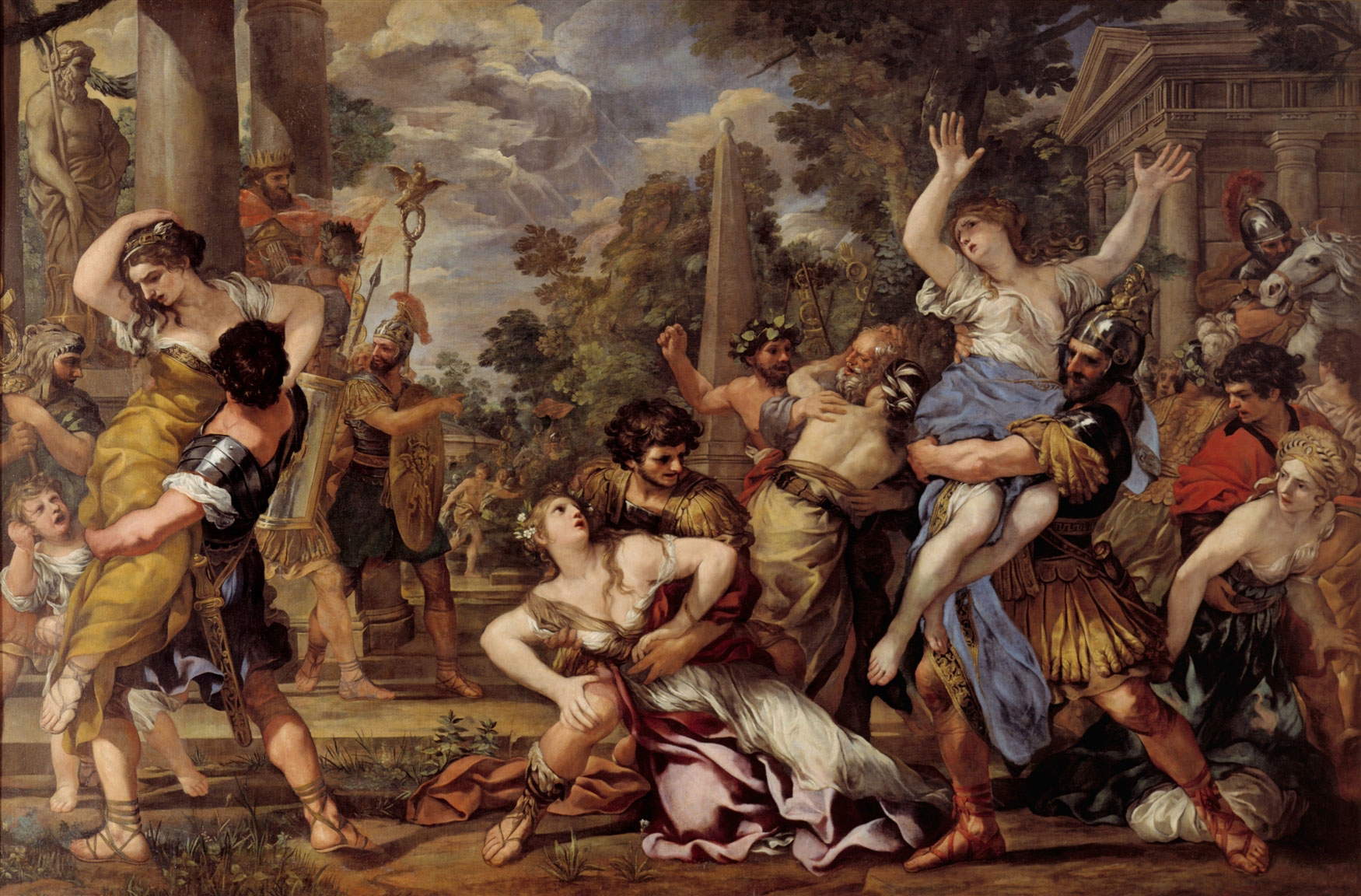 |
| Pietro da Cortona, The Rape of the Sabine Women (1630; oil on canvas, 280 x 426 cm; Rome, Musei Capitolini - Pinacoteca Capitolina) |
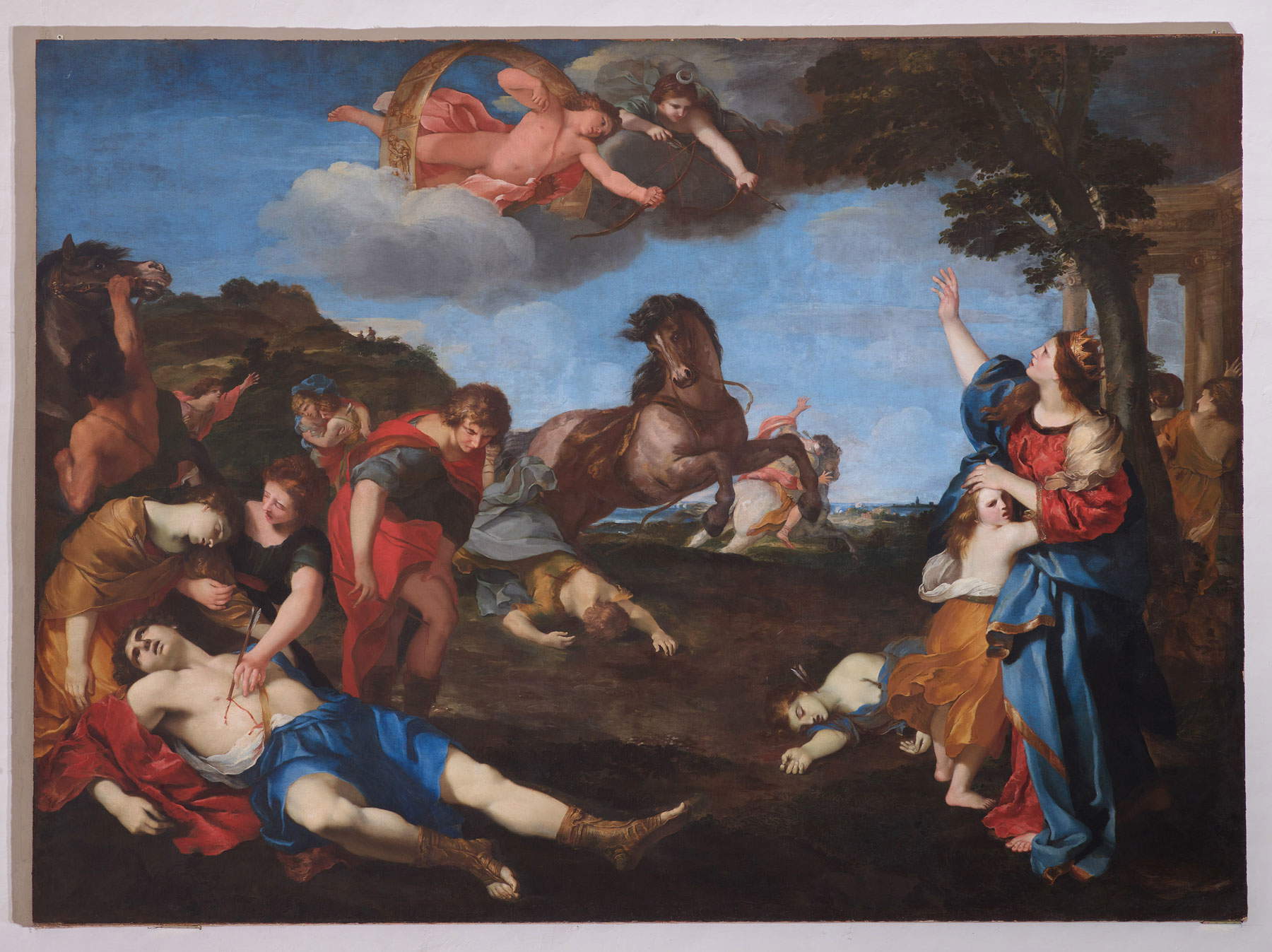 |
| Andrea Camassei, Strage dei Niobidi (1638; oil on canvas, 300 x 410 cm; Rome, Gallerie Nazionali di Arte Antica) ©(MiC) - Bibliotheca Hertziana, Max Planck Institute for Art History/Enrico Fontolan |
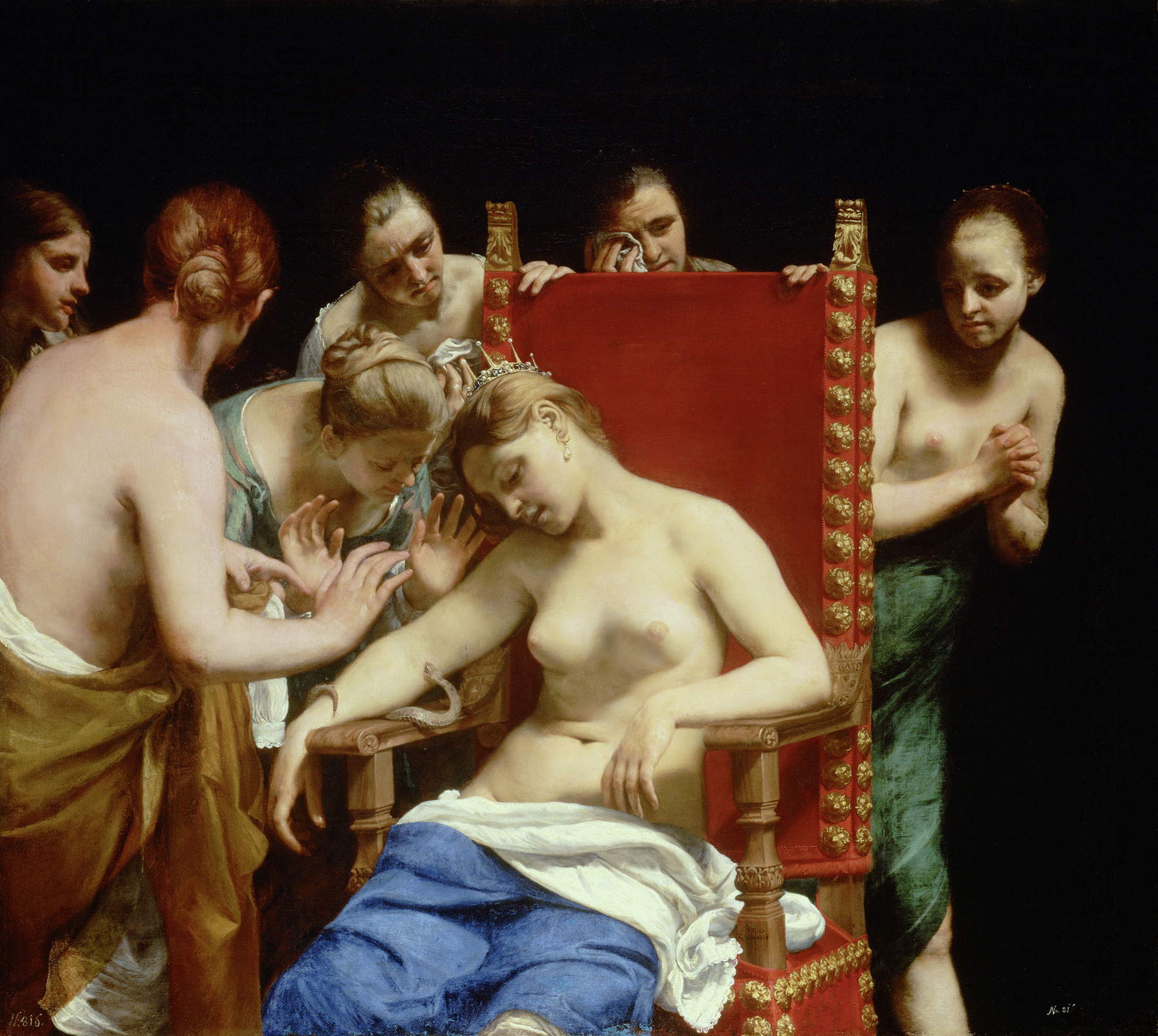 |
| Guido Cagnacci, Death of Cleopatra (1661-1662; oil on canvas, 153 x 169 cm; Vienna, Kunsthistorisches Museum, Gëmaldegalerie) ©KHM-Museumsverband |
In conclusion, this is an exhibition that chooses and develops well a significant theme, an interesting thread of a short journey through the stylistic and iconographic richness of Baroque art, proposing one next to the other important works of the seventeenth century, and not a few masterpieces, from the National Galleries of Rome itself but also from the rest of Italy and abroad, through a clear and coherent path, able also to dialogue (as it needed to do) with the host building. Forty works are exhibited, and their choice, as well as their placement in the various rooms according to the structuring by subject matter seen, is always apt and effective.
Panels serve as useful aids, and a good catalog, published by Officine Librarie, is available for purchase, allowing those who wish to explore the historical and artistic context in which the works on display were created. It is also possible to download online or pick up free of charge at the ticket office a children’s album that contains a short simplified guide to the different sections of the itinerary, and, at the end, some pages designed to make young visitors draw, thus inviting them to appropriate, by freely reworking them, the contents of the exhibition.
It is perhaps important to add that, although tickets can be purchased for the exhibition alone, the visitor who has never walked the halls of Palazzo Barberini is strongly advised to do so, also, but obviously not only, in order to appreciate from life one of the happiest expressions of Baroque magniloquence, The Triumph of Divine Providence to which, as mentioned, the exhibition dutifully returns.
Warning: the translation into English of the original Italian article was created using automatic tools. We undertake to review all articles, but we do not guarantee the total absence of inaccuracies in the translation due to the program. You can find the original by clicking on the ITA button. If you find any mistake,please contact us.